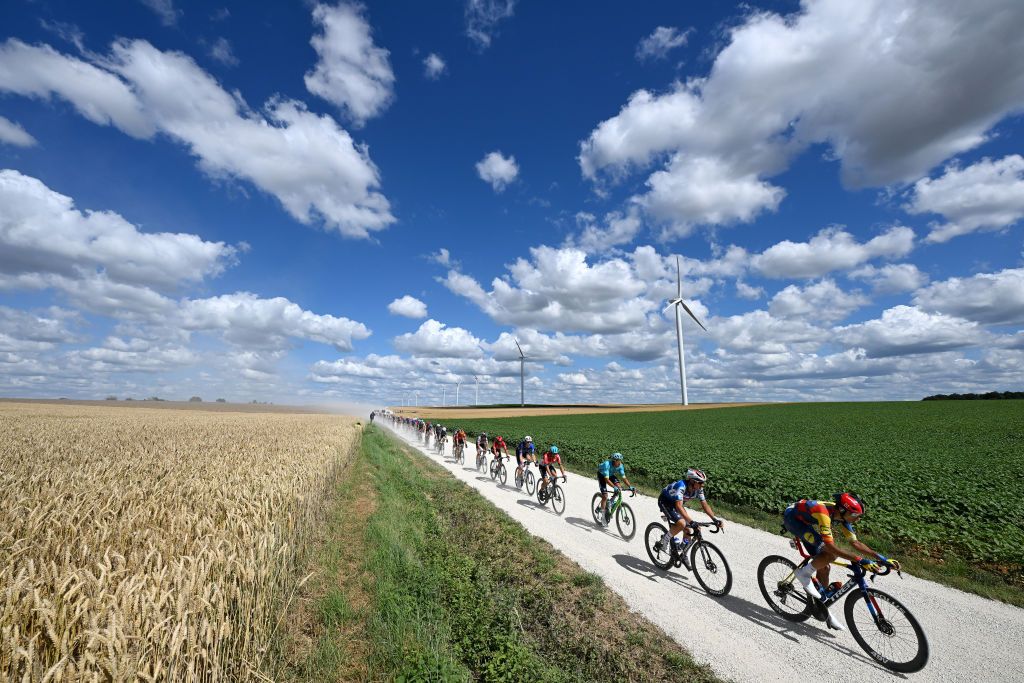As is always the case when a Grand Tour incorporates ‘off-road’ sectors into its parcours, opinion on the gravel-heavy stage 9 of the Tour de France in Troyes has been mixed.
The race has memorably visited the cobbles of Paris-Roubaix in the past and has also included gravel roads at the Plateau des Glières, too. Sunday’s stage was the biggest day of gravel roads yet at the race, however.
All-in, the peloton took on 32.3km of ‘chemins blancs’ spread across the 199km of the stage. The day, won by Anthony Turgis, didn’t deliver any major GC movement, but even so, strong opinions on the gravel were offered by riders and team staff alike.
Points classification leader and double stage winner Biniam Girmay was among the riders animating the race. The Eritrean Classics star was part of a group chasing down the main breakaway as he sought to score more green jersey points and challenge for the stage.
He’d end the day in ninth place, extending his points lead by six as he and Mathieu van der Poel didn’t manage to chase down Turgis’ group. Despite a solid result, he wasn’t overly positive about the gravel roads, saying the stage was a lot different to how it appeared on paper beforehand.
“Today, it was different than it was on the profile,” Girmay said. “We expected that it was going to be a gravel race on paper, but we had really steep climbs. The sectors are also different than we did a couple of months ago in the recons.
“We expected to be arriving with 40-50 guys, but I think it surprised me, especially after the first two sectors when we reached the intermediate sprint. There was like a real wall of a climb there.
The latest race content, interviews, features, reviews and expert buying guides, direct to your inbox!
“Today, I found myself in an uncomfortable place,” he added. “I was thinking ‘OK, maybe I can survive’, but on every single sector and every last kilometre, I felt super bad. But I just wanted to gain as many points as I can. We couldn’t bring back the first group, but at least we got a couple of points before the rest day.”
Race leader Tadej Pogačar was one voice who came out in favour of the gravel, the Slovenian, of course, having titles at Strade Bianche and the Jaén Paraiso Interior on his palmarès. He said after the stage that the reason for his multiple attacks during the day was “Just that I like to ride on the gravel, I guess. It’s in my nature, I think.”
Another voice in opposition to the gravel was the teammate of Pogačar’s yellow jersey rival Remco Evenepoel. Belgian Classics specialist Yves Lampaert is no stranger to racing like this, even if he’s raced more often on the Flandrian cobbles than on gravel roads.
Echoing Girmay’s comments, he told Het Nieuwsblad, after the stage that the race profile didn’t show the very steep climbs experienced by the peloton, while he also noted that the gravel was far looser than the sterrato of Strade Bianche.
“The approaches to the sectors were like having to ride the Koppenberg. So steep,” Lampaert said. “That’s why you start each sector with sore legs. I put out enormous watts and still didn’t make it into the sector – that says it all. It was actually a Classic.
“The sectors were a bit close together, and they added too much gravel. At Strade Bianche, the gravel was much more compacted and there you have the wheel tracks of cars in which to ride. Here, it was loose gravel. You’re dependent on luck – not to have misfortune or to be behind someone who can’t control his bike. It was a bit too much today, for me.”
Klaas Lodewyck, one of the directeurs sportifs guiding Evenepoel and Lampaert at Soudal-QuickStep this Tour, was another surprised by the state of the gravel.
“The last six sectors were just raised gravel,” he said. “[The organisers] made it artificial. I think that’s a shame and that it’s treacherous because the guys who reconned it – almost everyone – would be in for a big surprise.”
Team boss Patrick Lefevere has previously offered up the strongest objections to including such roads in Grand Tours, once again criticising them in a newspaper column last week. The Belgian’s opinion is largely shared by Red Bull-Bora-Hansgrohe directeur sportif Rolf Aldag, who spoke after the stage.
“I still don’t like it in a Grand Tour. I love it to watch it, but unfortunately, I’m not in a spectator seat, I’m part of the race,” Aldag said. “There are big investments into teams, and you want to leave nothing to pure luck or something. If Remco slips off and breaks his collarbone at sector 8 or whatever, then would you still enjoy watching it? Or would you say, ‘Maybe better not’.
“It didn’t happen beside Aleksandr Vlasov, who crashed really hard, but that could have happened in every other stage as well. So therefore, I think, leave it to the experts to do their race. Why not do that race in the future, if you feel like, with experts, like you do at Paris-Roubaix or Strade Bianche?”
Aldag did, however, admit that the racing – which saw the breakaway battle for the stage win as yellow jersey contenders Remco Evenepoel and Tadej Pogačar traded attacks back in the peloton – was entertaining.
“I have to say that from the view of a spectator, what Tadej is doing there, how Visma react, it’s pretty impressive. There’s no doubt that it’s entertaining. So, I understand why people say they love it.”
Get unlimited access to all of our coverage of the Tour de France – including breaking news and analysis reported by our journalists on the ground from every stage of the race as it happens and more. Find out more








:max_bytes(150000):strip_icc()/roundup-writereditor-loved-deals-tout-f5de51f85de145b2b1eb99cdb7b6cb84.jpg)


